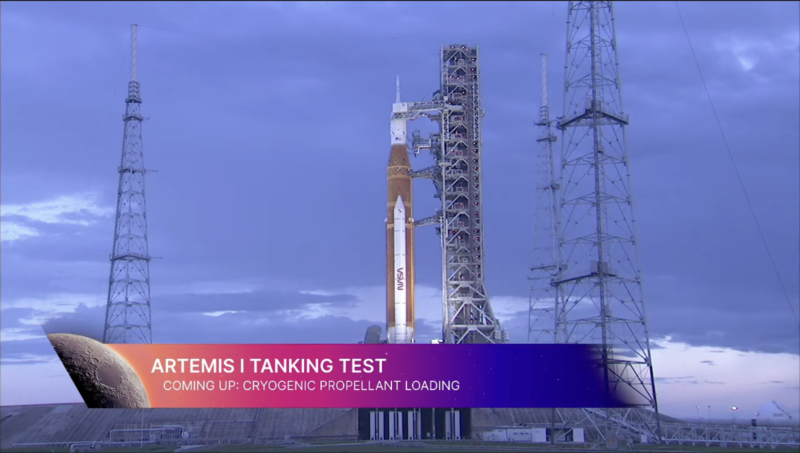
Update: The fiber optic cable providing Internet got cut with a chainsaw at 12:25 PM CDT. It’s Texas; what can I say. Here belatedly is the coverage that would have otherwise taken place.
A special thanks should be extended to Derail Nail, who is with NASA’s communications team, for his excellent and timely narration of today’s test.
7: 15 AM ED Wednesday, September 21, 2022
Awaiting KSC Launch Director Charlie Blackwell Thompson to give permission to begin cryo loading. NASA will be using it’s new “Kindler, Gentler” cryo loading procedure today. This test is being broadcast on NASA’s YouTube channel.
Note: This post will be updated periodically during today’s Artemis 1 cryo loading test of the liquid hydrogen and oxygen tanks.
Once both of the liquid oxygen (LOX) and liquid hydrogen (LH2) tanks are fully loaded, the test will be completed. This is expected to occur at around 3 PM EDT. The solid rocket boosters and the Orion spacecraft will not be powered-up during today’s test. This is only about loading-up the cryo tanks.
There an issue of the electrical room pressurization, located on the Mobile Launch Platform. The room is pressurized with inert gas, nitrogen, prior to cryo loading. That issue has been fixed. Once the team that fixed it is back, cryo loading will begin.
7:32 AM EDT
KSC’s Artemis Launch Director Charlie Blackwell Thompson has given the “Go” to being the cryo loading test.
One of the goals of this test will be to test the cryo loading procedures that are designed to be less stressful on. the launch vehicle. This will mean that fully loading both of the LOX and LH2 tanks will take an additional 30 minutes.
7:36 AM EDT
Beginning of the cryo loading test is a bit late. This is due to one of the members of a team that went out to fix a problem with the inerting of an electrical room located on the Mobile Launch Platform (MLP) not be accounted for in clearing the blast area. This person was just outside the blast area, an area that must be cleared for cryo loading to begin. A security guard was sent out to get this individual clear of the area.
7:39 AM EDT
Circulation pumps and heaters have been turned-on. The valves for the liquid oxygen and liquid hydrogen are being prepared to open. The ground launch sequencer computer (GLS) is now on.
7:42 AM EDT
The chill-down of the lines to the hydrogen cryo sphere have begun.
The LH2 cryo sphere can hold 900,000 gal. A new LH2 cryo sphere is under construction.
The Artemis Core Stage is 212 feet tall. The capacity of its tanks are:
537,000 gal of LH2
196,000 gal of LOX
LOX loading is the long-pole in cryo loading and will take 3 hours.
7:54 AM EDT
Chill-down of the lines that run from the LOX cry sphere has begun. This is a 15 minute operation.
8:42 AM EDT
Slow fill of loading of the liquid of the liquid oxygen tank has begun.
Just received “Go” to chilling down the lines that run from the LH2 cryo sphere.
9:09 AM EDT
Liquid Hydrogen tank on the Artemis 1 Core Stage is now in slow fill.
Liquid oxygen tank continues in slow fill.
9:25 AM EDT
LOX tank stands at 16% full. The LOX pumps are going to be slowed a bit there are requirements on how full the LOX tank can be relative to the LH2 tank since the LOX tank is atop the LH2 tank.
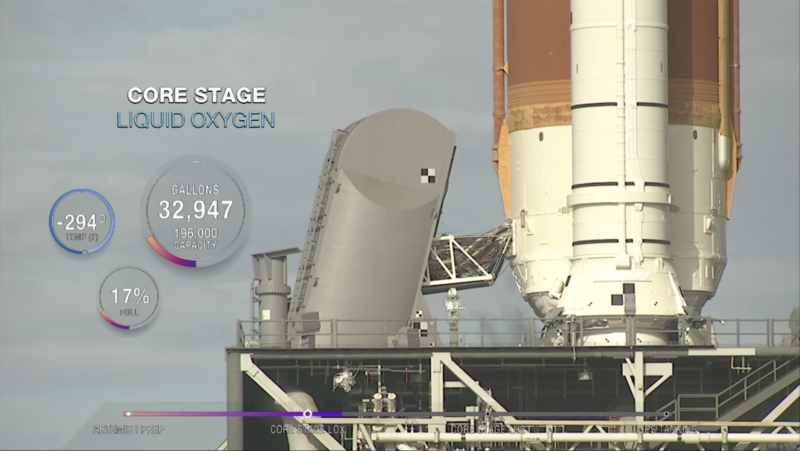
Interesting note. LH2 tank isn’t filled with pumps but with pressure from LH2 expanding as it heats in transit.
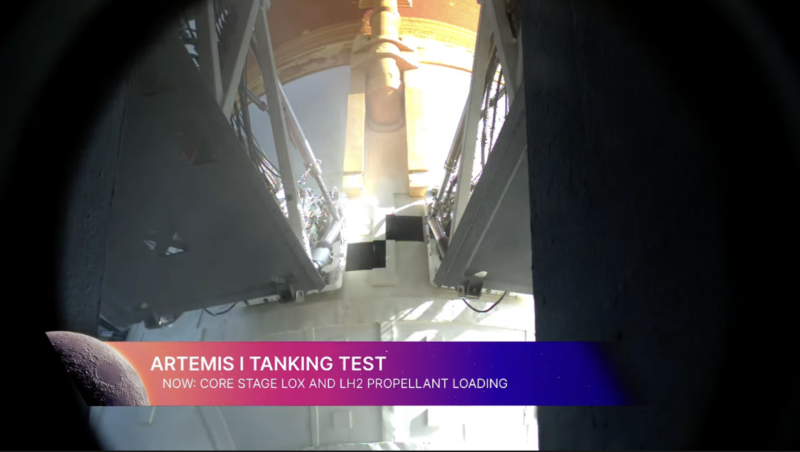
9:50 AM EDT
The LOX tank on the Artemis 1 Core Stage is 32% full.
LH2 slow-fill started at 9:09 AM EDT. The filling during the last 42 minutes has been slower than expected.
A temp sensor on inlet side of the bottom of the Artemis 1 Core Stage, which is used to allow fast-fill of LH2, was giving unusual readings. The launch team determined that the sensor was faulty and switched to a backup sensor. Fast-fill of the LH2 tank is set to begin soon.
10:00 AM EDT
Stop-flow on the LH2 tank on the SLS Core Stage just announced.
10:01 AM EDT
A hydrogen leak was detected in the cavity where the LH2 enters the Core Stage at the 8″ quick disconnect. The reading was 7% hydrogen. When stop-flow was done, the lead detection went away.
11:07 AM EDT
Update on LH2 leak on Artemis 1 launch vehicle at the Tail Service Mast Umbilical (TSMU), where the 8″ and 4″ umbilical lines connect to a quick-disconnect (QD). The seals on those lines connecting the QD to the launch vehicle were replaced two weeks ago. A leak was detected on the 8″ QD, reaching 6%. The cryo loading team recommended, and Launch Director Charlie Blackwell Thompson approved, a troubleshooting plan to try and seal the leak.
This was a pre-planned procedure that the team goes through when a hydrogen leak is detected. This is similar to a procedure done during the third launch attempt on September 3rd. The line is purged LH2, allowing the line to warm-up, and then resume flow of LH2 in the hope that the QD will reseat itself.
But the team made a change in the procedure since then. In this procedure, the pressure is dropped on the cryo sphere to less than 5 psi (over ambient pressure of ~14.7 psi), a very low pressure for this operation, and then as flow from the cryo sphere is recovered the team will very slowly step-up the pressure on the LH2 umbilical.
11:18 AM EDT
The cryo loading team is in revert and recovery, it has run the procedure to reseat the 8″ QD by letting the line warm-up. Now getting ready to flow LH2 into the rocket from the tail service mast umbilical (TSMU).
11:35 AM EDT
Now in LH2 fast-fill into the LH2 tank to verify a troubleshooting plan to reseal a leak at the LH2 8″ line.
11:44 AM EDT
LH2 fast-flow has resumed and the LH2 Core Stage tank stands at 14% filled.
There was a discussion by engineers and Launch Director Charlie Blackwell Thompson about getting data about the 8″ QD that leaked. The 8″ QD, as well as the 4″ QD too, is a pressure assisted seal. The pressure on the line is currently the same as it was when the leak started and resulted in 6% hydrogen concentration in the 8″ QD area.
At this time, the concentration of hydrogen is 1/2%. The constraint is 4%.
The engineers are tracking to see if the amount of hydrogen leaking is relative to the pressure being applied to the 8″ QD line.
SLS Chief Engineer John Blevins and others requested that they be able to gather data on any hydrogen leak as the pressure on the 8″ QD line is raised. They want to gather data to see at what point the leaking of hydrogen changes with pressure.
In the first run, the cryo team went straight to 10 psi from slow-fill to fast-fill. But in this case, the pressure is being stepped-up slowly.
SLS Chief Engineer John Blevins and EGS Chief Engineer asked the Launch Director to have a contingency plan in place if the leaking of hydrogen results in a concentration that reaches more than 10% or less for more than 5 minutes in the 8″ QD cavity. If it goes above 10%, then they will go to stop-fill. Launch Director Charlie Blackwell Thompson want the team to put in place plans if the concentration of hydrogen spikes.
The LH2 8″ QD has been troublesome. The launch team really wants to closely watch what happens when the pressure rises and the flow of LH2 increases into the rocket through the umbilical line in the TSMU.
The leak is at the 8″ QK plate that is right up against the rocket and connects the umbilicals to the rocket. Right now, the team wants to maintain a slow-flow to track the pressure, rate of leak of hydrogen, and gather the data that results from that. This is the contingency plan in place and is approved by the Launch Director as they raise the pressure of LH2 to get to a faster rate of fill of the LH2 tank.
Currently, the Core Stage LH2 tank is 17% full and the LOX tank is 89%.
The goal of the day’s Demonstration Test is to fill all four of the cryogenic tanks, that is the LOX and LH2 tanks in the Core Stage and the LOX and LH2 tanks on the second stage, or Interim Cryogenic Propulsion System (ICPS) in order to determine if the seal on the LH2 line will hold.
11:56 AM EDT
A procedure to reseat the LH2 8″ QD connection into the Artemis 1 launch vehicle Core Stage appears to have worked. LH2 is now at a pressure needed for fast-fill of the LH2 tank on the Artemis 1 SLS Core Stage.
To recap, after a hydrogen leak was detected at the 8″ quick disconnect (QD) at the TSMU, the launch team’s cryogenics group approached Launch Director Charlie Blackwell Thompson to get permission to try troubleshooting procedure to fix the leak. This involved stopping the flow of LH2 in order to let the connection between the quick-disconnect and the rocket warm-up. It was hoped that this would reseat the connection and seal the leak.
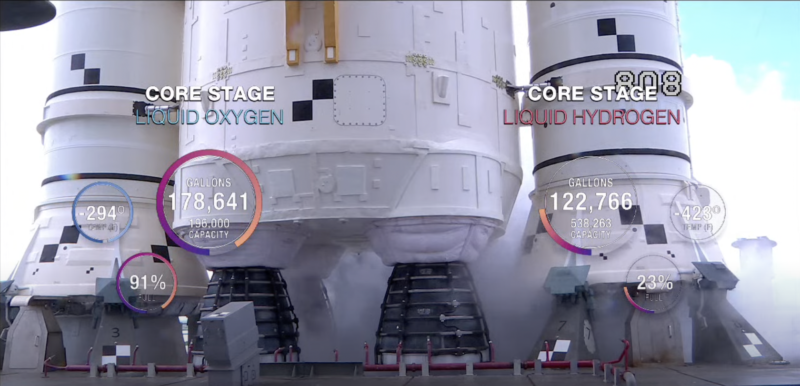
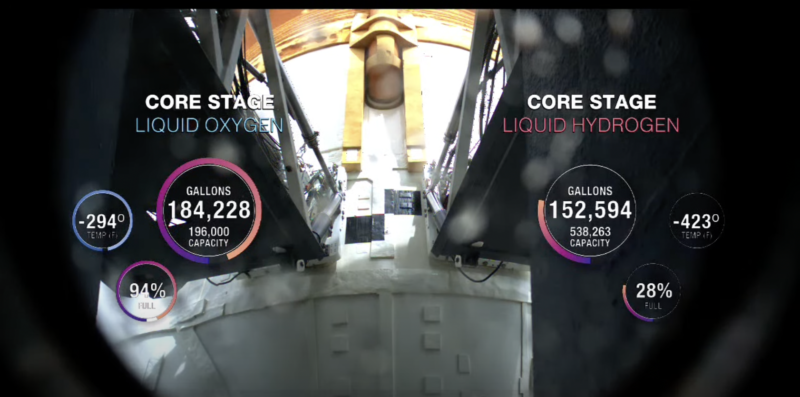
12:01 PM EDT
The LH2 tank on the Artemis 1 launch vehicle’s Core Stage just reached 30%. Fast-fill of the LH2 tank continues.
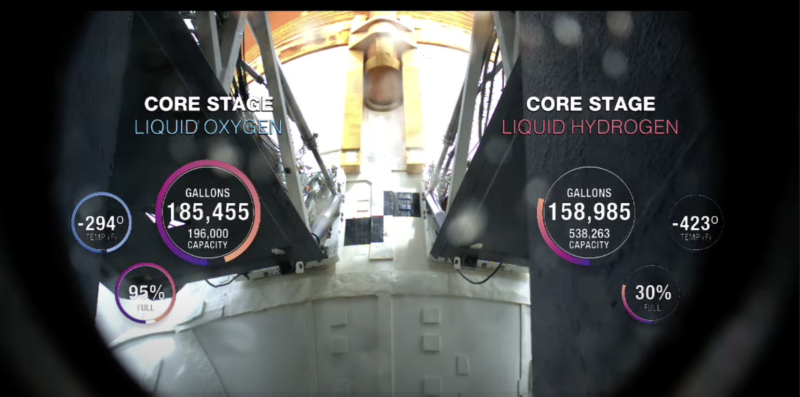
12:05 PM EDT
The launch team has just updated the Launch Director Charlie Blackwell Thompson on a plan to proceed with the next major milestone, the engine bleed kickstart with the LH2.
In order to do this, there are several lines that pull LH2 back out of the rocket after it has run through the RS-25 engines. This is a critical step since the bleed thermally conditions the engines for launch.
The launch team will pre-chill a 4″ and 6″ bleed line that comes off the engines and vents the LH2 out of the engines. It’s a pressurized bleed to get it kicked-off. A gaseous hydrogen vent is closed to build-up pressure, then a small amount of LH2 is bled through the engines.
LH2 tank is, at 190,518 gal out of 538,2263 gal, 35% full and the launch team is monitoring a leak resulting in a less than 1% concentration of hydrogen. The LOX tank is 98% full at 191,997 gal out of 196,000 gal.
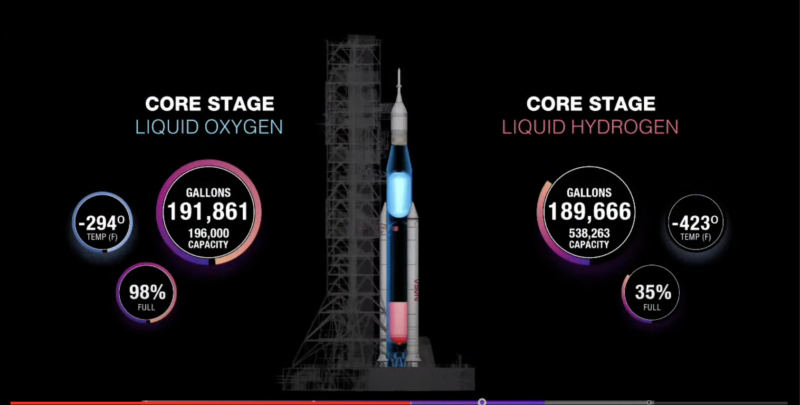
12:08 PM EDT
Engine bleed kickstart of the 4 RS-25’s with LH2 running through the engines and then vented off the rocket has begun.
The LOX tank is now 98% full and is in top-off fill.
12:08 PM EDT
The LH2 vent valve on the rocket was closed to build-up pressure part of the LH2 engine kickstart.
The hydrogen leak rate is over 1%.
12:16 PM EDT
The LH2 pressure has built-up to that needed for the engine kickstart of the RS-25’s. The concentration of leaked hydrogen on the 8″ quick-disconnect is over 3%. It topped-out at 3.4%. It’s tracking with an increase in pressure. But the kickstart bleed is now at the point where the valves will open to start the process.
12:20 PM EDT
The kickstart engine bleed of the 4 RS-25 engines with LH2 is now complete. The gaseous hydrogen vent line is now open.
At this point, the team will transition to the vented bleed of LH2 on the RS-25 engines and returns to filling the LH2 tank.
LH2 is still leaking at the 8″ QD, but at 3%, which is within the 4% tolerance.
LOX fast fill is complete.
LH2 is continuing to fill after a kickstart bleed to the 4 RS-25 engines, to get the lines in the engines filled with LH2, was completed.
12:24 PM EDT
The LH2 tank on the Core Stage is now 50% full. The LOX tank is in top-off mode.
12:42 PM EDT
The launch team is discussing where to go from this point.
The LOX tank is 100% and are replenish.
The LH2 tank is at 67%. The team successfully dealt with a hydrogen leak on the LH2 8″ quick-disconnect that connects to the rocket.
The plan is to gradually increase the pressure of the LH2 cryo sphere storage tank that will increase the pressure on the LH2 8″ quick-disconnect as well. This increase in pressure will get the flow of LH2 into fast-flow that would be nominal for a launch attempt.
Launch Director Charlie Blackwell Thompson has signed-off on slowly stepping-up the pressure on the LH2 cryo sphere storage tank. Meanwhile, the launch team will keep track of the hydrogen leak at the LH2 8″ quick-disconnect.
Once the LH2 tank on the Core Stage is full and in replenish mode, the next step is a pre-press test, to pressurize the LH2 tank for launch, another test objective. That is the pressurization of the tank to get to a high-flow bleed going needed to start the RS-25 engines.
If the hydrogen leak in the LH2 8″ quick-disconnect cavity reaches a concentration of over 4% for 5 minutes, then a stop-flow command will be issued.
The LH2 tank on the Core Stage is currently at 70%.
The launch team is on hold for the upper stage (ICPS) cryo loading.
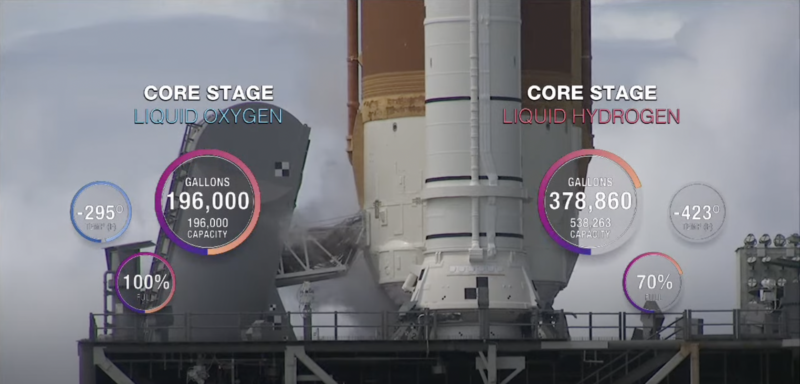
1:11 PM EDT
The LH2 tank on the Artemis 1 Core Stage is now full and is in replenish mode. Fast-fill of the LH2 tank is completed. The valves into the LH2 tank on the Core Stage is only open enough to fill LH2 from boil-off.
Interesting data. During the fast-fill operation, where the cryo sphere storage tank was at full pressure for loading LH2 into the LH2 tank on the Core Stage, the leak concentration of hydrogen was 1/2%, a very manageable level.
1:15 PM EDT
We are going to take a break at this time. It’s been a long morning. We’ll be back soon.
3:47 PM EDT
The Artemis 1 Core Stage LH2 pre-press test is completed. Engineers on the launch team have achieved the pressure they were looking for in the 4 RS-25 engines with the high-flow engine bleed of LH2.
With the completion of the pre-press test, the LH2 team is going to get back into loading LH2. To conduct the pre-press test requires closing-off the fill-and-drain, the fuel line, of LH2. Now that valve will be re-opened to replace the propellant that was lost during the pre-press test.
3:54 PM EDT
The LH2 tank on the Artemis 1 Core Stage is back in replenish.
The team is now working on the LH2 upper stage (ICPS) tank. There is a loop that adds propellant that has gone over. The team is trying to get the upper-stage’s LH2 tank settled on 100%.
3:59 PM EDT
Correction: The hydrogen leak on during the LH2 pre-press test was on the 4″ quick-disconnect, not the 8″ quick-disconnect. The 4″ QD is for the engine bleed line.
4:06 PM EDT
The upper-stage LH2 tank is in replenish and stabilized.
4:10 PM EDT
Nominal replenish for the Core Stage cryo tanks.
Engineers report that the LH2 pre-press test went very well. They were able to dial-in the bleed position on the engines. The test took 15 minutes, much shorter than the 1 hour originally scheduled. The engineers say that the pre-press control got them dialed in quickly enough that they were able to raise and lower the pressure in the desired range.
The LH2 team addressed the increased concentration of hydrogen, which got up to a little over 5% during max pressure for the bleed system, due to a leak on the 4″ bleed quick-disconnect. But as flow continued, the leak rate lowered on its own and with no input on their side.
A 5% concentration of hydrogen would have stopped the count but was within the parameters set for the today’s test.
The LH2 team has almost stabilized the LH2 tank replenish on the upper-stage LH2 tank.
4:30 PM EDT
The LH2 team reports that they have completed dialing-in the replenish flow for the upper-stage LH2 tank, located on the ICPS.
Launch Director Charlie Blackwell Thompson just finished hearing from her engineers on the launch team on the loop. They report that they have completed all of the objectives for the Cryogenic Demonstration Test today.
A go for cut-off was given, which puts the ground launch sequencer into a safing sequence, which comes just before de-tanking the launch vehicle both on the Core Stage and in the upper-stage.
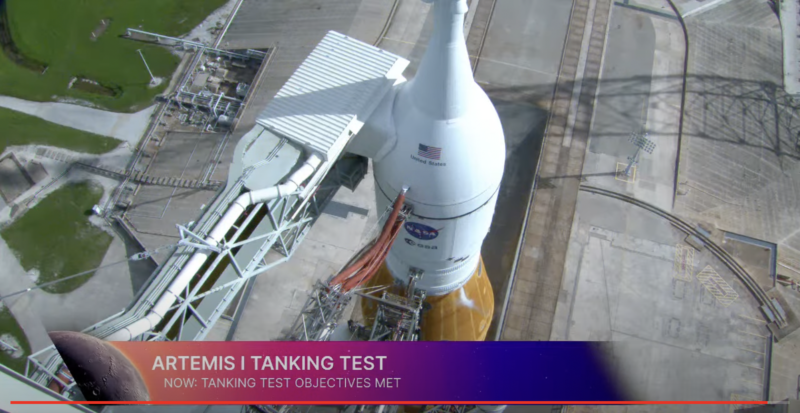





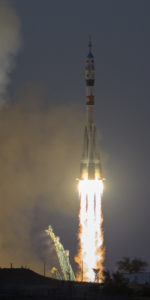
2 Comments
2 Pings & Trackbacks
Pingback:First SLS Flies, Turns Florida Night into Day - AmericaSpace
Pingback:First SLS Flies, Turns Florida Night into Day - Space News